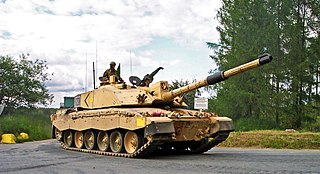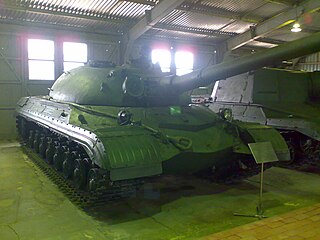
Mechanized infantry are infantry units equipped with armored personnel carriers (APCs) or infantry fighting vehicles (IFVs) for transport and combat.

The IS tanks were a series of heavy tanks developed as a successor to the KV-series by the Soviet Union during World War II. The IS acronym is the anglicized initialism of Joseph Stalin. The heavy tanks were designed as a response to the capture of a German Tiger I in 1943. They were mainly designed as breakthrough tanks, firing a heavy high-explosive shell that was useful against entrenchments and bunkers. The IS-2 went into service in April 1944 and was used as a spearhead by the Red Army in the final stage of the Battle of Berlin. The IS-3 served on the Chinese-Soviet border, the Hungarian Revolution, the Prague Spring and on both sides of the Six-Day War. The series eventually culminated in the T-10 heavy tank.

The Kliment Voroshilov (KV) tanks are a series of Soviet heavy tanks named after the Soviet defence commissar and politician Kliment Voroshilov who operated with the Red Army during World War II. The KV tanks were known for their heavy armour protection during the early stages of the war, especially during the first year of the German invasion of the Soviet Union. In certain situations, even a single KV-1 or KV-2 supported by infantry could halt German formations. The German Wehrmacht at that time rarely deployed its tanks against KVs, as their own armament was too poor to deal with the "Russischer Koloss" – "Russian Colossus".

The T-80 is a main battle tank (MBT) that was designed and manufactured in the former Soviet Union and manufactured in Russia. The T-80 is based on the T-64, while incorporating features from the later T-72 and changing the engine to a gas turbine. When it entered service in 1976, it was the first production tank to be powered solely by turbine.

Soviet armoured fighting vehicle production during World War II from the start of the German invasion of the Soviet Union on 22 June 1941 was large. Although the Soviet Union had a large force of combat vehicles before the German invasion, heavy losses led to a high demand for new vehicles. Production was complicated by the loss of production facilities in the western part of the Soviet Union, and entire factories were moved east of the Ural Mountains to put them out of reach of the Germans. In general, Soviet tanks had less interior space than the tanks of other nations – this was possible because the Red Army only employed soldiers of small stature in their tank forces.

The SU-152 is a Soviet self-propelled heavy howitzer used during World War II.

The ISU-122 was a Soviet assault gun used during World War II, mostly in the anti-tank role.

The T-84 is a Ukrainian main battle tank (MBT), based on the Soviet T-80 MBT introduced in 1976, specifically the diesel engine version: T-80UD. The T-84 was first built in 1994 and entered service in the Ukrainian Armed Forces in 1999. Its high-performance opposed-piston engine makes it a fast tank, comparable to other modern MBTs with a power-to-weight ratio of about 26 horsepower per tonne.

Heavy tank is a term used to define a class of tanks produced from World War I to the end of the Cold War. These tanks generally sacrificed mobility and maneuverability for better armour protection and equal or greater firepower than tanks of lighter classes.

Tank classification is a taxonomy of identifying either the intended role or weight class of tanks. The classification by role was used primarily during the developmental stage of the national armoured forces, and referred to the doctrinal and force structure utility of the tanks based on design emphasis. The weight classification is used in the same way truck classification is used, and is intended to accommodate logistic requirements of the tanks.

The BA-10 was an armored car developed in the Soviet Union in 1938 and produced through 1941. It was the most produced Soviet pre-1941 heavy armored car – 3311 were built in three versions. These versions were the BA-10, the BA-10M, and the BA-10ZhD. The basic BA-10 design was developed from the BA-3 and BA-6 heavy armored cars. It had an improved GAZ-AAA chassis and improved armor. It was intended that the BA-10 would be replaced in 1941 by the BA-11 with diesel engine and more sophisticated armor design, but the outbreak of war prevented BA-11 production. The BA-10 was in Red Army service until 1945. Significant numbers of captured BA-10s were used by Finland, Germany and other Axis powers in Europe.
Tank development both evolved considerably from World War II and played a key role during the Cold War (1945–1990). The period pitted the nations of the Eastern Bloc and the North Atlantic Treaty Organization (NATO against each other.

A main battle tank (MBT), also known as a battle tank or universal tank, is a tank that fills the role of armour-protected direct fire and maneuver in many modern armies. Cold War-era development of more powerful engines, better suspension systems and lighter composite armour allowed for the design of a tank that had the firepower of a super-heavy tank, the armour protection of a heavy tank, and the mobility of a light tank, in a package with the weight of a medium tank. The first designated MBT was the British Chieftain tank, which during its development in the 1950s was re-designed as an MBT. Throughout the 1960s and 1970s, the MBT replaced almost all other types of tanks, leaving only some specialist roles to be filled by lighter designs or other types of armoured fighting vehicles.
This article deals with the history and development of tanks of the Soviet Union and its successor state, the Russian Federation; from their first use after World War I, into the interwar period, during World War II, the Cold War and modern era.

The IS-7 heavy tank, also known by its project name Object 260, is a Soviet tank that began development in 1945. The vehicle existed only in prototype form and was cancelled in favor of the T-10 tank.

The IS-3 is a Soviet heavy tank developed in late 1944. Its semi-hemispherical cast turret became the hallmark of post-war Soviet tanks. Its pike nose design would also be mirrored by other tanks of the IS tank family such as the IS-7 and T-10. Too late to see combat in World War II, the IS-3 participated in the Berlin Victory Parade of 1945, in the border conflict during the Sino-Soviet split, the Soviet invasion of Hungary, the Prague Spring, on both sides during the Six-Day War, and in very limited capacity during the Russo-Ukraine War.

The IS-2 is a Soviet heavy tank, the second of the IS tank series named after the Soviet leader Joseph Stalin. It was developed and saw combat during World War II and saw service in other Soviet allied countries after the war.

The Object 770, was a prototype Soviet heavy tank designed in 1956, and was one of the last heavy tanks ever produced. It was developed alongside the Object 277 and the Object 279 following the Decree of the Council of Ministers of the USSR on August 12, 1955. Development was cancelled in 1960 following Nikita Khrushchev's orders to stop production of all heavy tanks weighing over 37 tons.

The Obiekt 277 was a prototype Soviet heavy tank designed in 1957, one of the last heavy tanks to be produced by the USSR. Developed alongside its sister design, the Obiekt 278, as well as the Obiekt 279 and the Obiekt 770, Obiekt 277 was a conventional heavy tank, armed with a powerful gun and thickly armoured. All development was cancelled in 1960, as part of Nikita Khrushchev's wish to abandon what he deemed obsolete heavy tanks, and re-focus efforts on ATGMs.


















